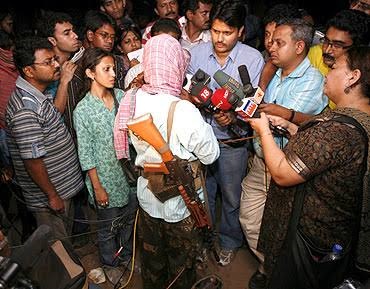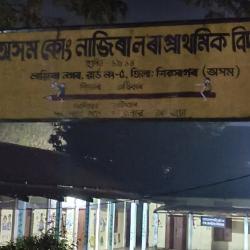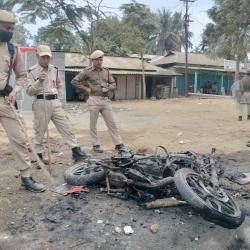Bastar region, the heartland of India inhabited by the aboriginals, has been under the grip of violence for four decades now. The primary reason behind this can be attributed to the shifting base of the Maoist revolution to its dense Dandakaranya forests.
The Maoist revolution, initiated from the village of Naxalbari in Bengal in 1967 under the party banner of CPI (ML), upon facing brutal repression by the state machinery in Bengal had shifted its base to the plains of Bihar. By then, the party had witnessed several splits with the People’s War Group and Maoist Communist Center making headlines about being at the forefront. After a brutal clash with the caste militant group Ranvir Sena in Bihar, the Maoists had run out of hiding spaces amidst the agricultural fields of Bihar. This helped them shift their base to the heartland of India in the Dandakaranya forests of Bastar and further reorganised themselves into a single party, the Communist Party of India (Maoism) in 2004.

A government primary school operated in a hut in highly sensitive village of Sukma. The hut structures help in avoiding the security forces from occupying the school buildings.
Dense forests flanked by rivers and tough geographical terrain almost devoid of the Indian State’s positive presence have helped the Maoists establish the region as their base. Any Communist guerrilla movement needs the support of the masses to flourish and thrive, and the Maoist movement was no different. The aboriginals inhabiting the forests were already facing the farce of the Indian State’s repressive policies on mining, atrocities inflicted upon them by the forest department officials, and a sheer apathy displayed towards the cause of development in the region. These factors summed up to give an excuse to continue the war for the Maoists inhabiting the region. They portrayed themselves as the messiah to the aboriginals and have been trying to impose the burden on continuing the protracted war for a better society as conceptualised by Mao Zedong on these egalitarian and organic communist communities.
The movement was also successful in setting up a sub-base in the Lalgarh area of West Bengal under the leadership of Kishen Ji during the final years of Left Font’s rule. The mass support generated was through the exploited aboriginals inhabiting the forests of West Bengal. Singur and Nandigram movements led by Trinamool Congress Chief Mamta Banerjee and the path of democratic protests and roadblocks undertaken by the Maoists and its sister organisations have taken the Maoist movement in India to its zenith’s height before it was finally banned in 2009. The mass support they enjoyed was wiped off after the fall of Left Font and the advent of Mamta Banerjee as the CM.
Presently Maoist movement in India has sustained to be one of longest running Communist Guerrilla movements in the world. In 2009, while it had reached its peak in terms of casualties of the war, it was mostly against the BJP-backed Salwa Judum militants in Bastar and the CPIM-backed Harmad Bahini militants in West Bengal. As per the data released by the Home Ministry, 720 civilians, including 323 alleged police informers and 281 security forces, died during the peak of the Maoist movement in 2010. The number reduced to around 85% in the year 2022. But the year-wise number of deaths in the last three years in the state of Chhattisgarh shows that Maoists are a cause to be threatened the state.
What is sustaining the Maoist problem?
The state of Chhattisgarh has been constantly refusing to view the problem as a socio-economic one. Late Dr. B.D. Sharma, an IAS and ex-collector of Bastar district in the undivided Madhya Pradesh turned activist, had been constantly stretching the fact that the Maoist problem is a socio-economic problem rather than a law and order problem. In an interview, he stated the primary reason for this violence as India is an unbroken chain of broken promises. Even various commissions set up by the then UPA Government at the center had been suggesting the same. But Chhattisgarh state has been viewing and acting, considering the problem to be a law and order situation.

A memorial for a slain cadre errected by the Maoists in a highly sensitive village of Bijapur to mark the area as their liberated zone.
First, the State Government had deployed Salwa Judum militants and had set them on a free killing spree of aboriginals in Chhattisgarh displacing around 3,50,000 aboriginals from 2005 onwards, and then have been deploying huge numbers of central security forces in Bastar after the onset of operation ‘Green Hunt’ under the behest of then Home Minister Chidambaram. Though the Central Government had been in denial of the existence of Operation Green Hunt just like the Chhattisgarh Government’s denial of Salwa Judum until it was banned and the West Bengal Government’s denial of the existence of Harmad Bahini, the sudden deployment of central forces in large numbers in the heartland of India cannot be explained otherwise. Arundhati Roy had rightly called Chidambaram the CEO of Operation Green Hunt. NIA was set up in 2008 by Chidambaram to deal with all the Maoist cases across the affected states and since then a large unaccounted number of arrests of the aboriginal forest dwellers under the suspicion of having Maoist links are being made that day.

A school demolished by Maoists to refrain the security forces from occupying the building during the Salwa Judum movement.
The militant group Salwa Judum was banned by the Supreme Court in the year 2011 acting upon a petition filed by Nandini Sundar, but the center states joint operations under Operation Green Hunt have continued. While the state boasts of a drastic reduction in casualties of the Maoist movement owing to its anti-Maoist joint operations, the loss of civilians’ lives during the war has resulted in Sarkeguda, Gompad, Edesmetta, Darbha Ghati, and Silger and the attacks of the government schools are deep scars in the face of Indian democracy.
The problem here is that while the state has been intensifying its joint anti-Maoist war operations, it has been reluctant to ensure social justice for the aboriginals of Bastar. The objective of the state is basically to sell the mineral-rich forests to the corporates and for this, the war is to be made more lethal even if it is costing innocent aboriginals their lives. It is being reported that the previous CM of Chhattisgarh, Dr. Raman Singh has already sold the forest lands to the corporates and signed MoUs.
The exploitation of aboriginals by the State, directing repressive policies towards them, not the implementation of the Forests Rights Act and Right to Education in the conflict-affected areas, and dilution of Gram Sabhas are the primary reasons why the Maoist movement is sustaining to date. Having a pro-aboriginal outlook towards the concept of development and ensuring them the rights enshrined by the Indian Constitution will reduce the mass support of the Maoists drastically and further pave the way for a political solution to the problem and peace-building in the region.
Waging a war against its Aboriginal citizens by the state to appease its corporate funders under the cover of Operation Green Hunt has only been escalating the problem. The Maoist movement needs a mass support base initially to thrive and the state’s apathy towards ensuring the rights of aboriginals has been helping the Maoists in generating this support. In March 2022 Kanchan Da, a central Committee member of the Maoists, was arrested by Assam. He was trying to generate mass support amongst the tea garden workers of Assam. Tea garden workers in Assam are also on the receiving end of the state’s repressive, pro-corporate and exploitative policies. The Maoists have been taking advantage of the state’s exploitation to expand its bases, and this is letting them sustain even after 75 years of independence. India’s anti-people neo-liberal policies are to be blamed for this.
Peace Talks - history and current prospects
Various attempts were made to initiate peace negotiations with the Maoists. The most notable efforts were made in 2004 by the state of Andhra Pradesh under the leadership of then CM Y.S. Rajasekhara Reddy. The ban on the Maoists was lifted temporarily and Varvara Rao and Swami Agnivesh were appointed as interlocutors for conducting the peace talks. Both parties in the war did sit over the table negotiating demands, but the ceasefire did not last long and was lifted in January 2005. Both parties have their versions against each other. Senior Maoist party members Azad and Ramakrishna were leading the talks. Further possibilities thinned further after the state of Andhra Pradesh killed Azad in an encounter in 2010 amidst peace talks.

Maoist leader Kishenji addressing the media
The second spark of the peace talks beamed during the peak of the Lalgarh movement in West Bengal under the leadership of senior Maoist party member Kishenji. Kishenji used to be a media sensation owing to his careful but frequent usage of mobile phones and regular press appearances. At the inception of the Lalgarh movement, Maoists were not banned in West Bengal as the allies of CPM in the Left Font Government were against the culture of the ban. Kishenji used to issue regular press releases inviting the state government for talks. But then the Maoists were banned from abiding by an order issued by the Central Government in 2009 and violence further escalated. Mamta Banerjee, a leader of opposition in the state, had promised peace talks once she attains power. In 2011, the Maoists had allowed the villagers to participate in the election process which had kicked the Left Font of power after a long 34 years of undisputed mandate. It is alleged that Maoists had also helped Mamta Banerjee to get the mandate in the jangalmahal area of West Bengal. After her Trinamool Congress party came to power in West Bengal, Mamta Banerjee had appointed two interlocutors for the peace talks upon repeated requests by Kishenji, but she never withdrew the security forces from jungles, a primary demand of the Maoists to initiate peace talks and thus breaking a pre-poll promise of her. Concerning their commitment to peace talks, the Maoists in Bengal had once ceased violence for a tenure of 72 hours asking the state to surrender arms against them, but the state did not comply. The state neither did release the aboriginals jailed under fake Maoist cases. Further possibilities thinned further after the encounter killing of Kishenji in 2011 amidst the peace negotiations.
In both sprees of peace talks, the primary demands of the Maoists were the withdrawal of security forces and the release of their jailed members. Both states were reluctant to fulfil.
Though not so prominent, Chhattisgarh also has its instances of peace negotiations between the state and the Maoists. The Maoists have been opposing the elections in the state and might oppose elections in the coming years based on their lessons from the encounter killing of Kishenji but they have been recently resorting to democratic means through non-violent protests to get their demands fulfilled. It is an open secret that the Maoists have been supporting the ongoing protests against the security camps and killings of innocents at Silger and other interior villages. Subhranshu Choudhury, a peace journalist, rightly points out that post-2020, most of the posters and banners issued by the Maoists have been mentioning the violation of ‘Constitutional rights of the villagers. But this doesn’t dilute the fact that Maoists reportedly killed more than 30 villagers in Bastar under the suspicion of being police informers in 2020 alone.
Subhranshu Choudhury had conducted a peace march in Bastar in 2021 to which the Maoists had initially reacted negatively threatening Subhranshu with dire consequences while alleging him to be serving the interests of corporates, but lastly, they came up with a charter of their demands for the peace talks.
Three primary demands placed by the Maoists in Chhattisgarh are the withdrawal of security forces, removal of a blanket ban on Maoists, and release of their leaders from jail. The Chhattisgarh Government has not compiled any of these demands and has been intensifying the deployment of security forces in the Bastar region and aggressive road construction in interior villages to facilitate the movement of forces (the villages cleared of Maoist influence in Bastar hardly have concrete roads). On a recent visit to the Konta Block in Sukma, CM Bhupesh Baghel had invited the Maoists for a talk but without any condition or demand. The Maoists never responded to this call.
Restoration of education infrastructure – an unsaid agreement toward peacebuilding
In early 2000s, during the peak of Salwa Judum-induced violence in Bastar, Maoists demolished government schools and buildings in the forests as retaliation to state violence. Ganapathy, an octogenarian and the then General Secretary of CPI (Maoism) had justified demolishing schools as those schools were occupied by the state forces to attack and kill the villagers in an open letter published in the Economic and Political Weekly in October 2006. Demolishing the schools had forced lakhs of aboriginal children inhabiting the forests of Bastar to go out of school.
A decade had passed since then, the schools were not re-built by the state whereas the state kept investing more and more in anti-Maoist warfare. In 2018, the then collector of Sukma re-opened 93 government primary schools in the highly sensitive zones also called ‘Liberated Zones’ of the Konta Block in Sukma. These schools were demolished and closed for more than a decade. These schools were re-opened by the collaborative efforts of the district administration and community members and Maoists mostly don’t hinder their operation. The Maoists allowed the teachers to operate the schools in their strongholds, NGO persons, and the education officials to access the areas and the state ensured the support from the district administration to ensure continuity of education of the conflict-ridden aboriginal children.
The state has also been operating residential schools called ‘Pota Cabins’ in the districts of Dantewada, Sukma, Bijapur, and Narayanpur since 2011 for the conflict-ridden and out-of-school children living in the sensitive zones. These schools are located near the towns and children need to travel long distances from their native villages in sensitive zones to reach these schools. These schools are a hub of rampant corruption, devoid of trained teachers, overcrowded, devoid of proper toilet facilities, books, living facilities, and proper food for the children, and are no less than detention centers. The major objective of setting up these schools is not to facilitate the continuation of the education of the ‘out of school children but rather to keep them away from their cultural roots by indoctrination of urban and anti-tribal cultures in them (Hindutva cultures which are not part of aboriginal lives are a part of the children’s lives in Pota Cabins). What will this yield for the state is these children moving away from their native villages once they grow up so that they register no rebellion against the government’s pro-corporate policies of aboriginal land grabbing in the future.
In comparison to the state’s initiative to operate the Pota Cabins, its initiative to re-open the closed schools during Salwa Judum in 2018 is worth applauding. Presently 300 demolished and closed schools have been reopened in Sukma, Bijapur, and Dantewada districts in the most sensitive and interior areas. These schools are ensuring the rights guaranteed to the aboriginal children under the RTE Act 2009. Children don’t have to travel long distances and are availing of education at their doorsteps. The schools are mostly operated in thatched huts which prohibits the security forces or Maoists to occupy the school building during the war. The Maoists have been reluctant to let concrete buildings be built in their strongholds owing to the possibility of them being occupied by security forces. The state government is sensitive to this reluctance of the Maoists and has been building half wall and polymer wall school structures in the sensitive areas. Both the Maoists and the state of Bastar, though parties to the war, are in an unsaid agreement to let the aboriginal children continue their education in these re-opened schools.
A recent state-conducted study was published by UDISE which claimed that in the last three years of the pandemic, 40,847 children in Bastar have dropped out of school. The study attributed this large number of dropouts to Maoist influences and the high costs incurred in high school education. The interpretation of the data has been largely faulty. While on one side Bupesh Baghel has been patting its back for re-opening 300 schools in highly sensitive areas of Bastar, in contradiction to it the study is citing Maoism as a primary challenge for pushing the children out of school. The Maoists are presently allowing the construction of schools, health centers, and Aanganwadis in their strongholds.
It is to be noted that the maximum number of children who dropped out are senior students who once used to study in Pota Cabins. After the lockdown, most of these children left for the nearby cities and took up construction work to never return to schools. The primary reasons are lack of quality education and lack of basic living conditions in these Pota Cabins owing to rampant corruption by the district administration. The status of assistance provided by the center has been allocating an amount of 1700 INR per month per child for 500 seated Pota Cabins. Even after the allocation of such a whooping amount, why is the state accusing the higher cost of education as a reason for dropping out of senior children? It shows the extent of corruption in the Pota Cabins.
The state should continue its exemplary efforts of re-opening the closed schools in the Maoist strongholds of Bastar with the collaboration of the villagers. Refraining from the game of blaming Maoist for its failures, the state should try to reduce the corruption in the Pota Cabins of Bastar and ensure quality education for the children. They should further consider building Aanganwadis, Hospitals, High Schools, and residential schools in those sensitive areas. Even though in war, both the state and the Maoists share a common consensus of letting children attend schools, villagers avail health facilities, and pre and post-natal mothers receive proper care in Bastar.
The Maoist problem is a socio-economic issue and needs to solve by implementing sustainable and pro-aboriginal socio-economic policies. Ideally, the state should drastically reduce the intensity of its war in Bastar and should ensure the constitutional rights of the aboriginals. But since that cannot be the case owing to the anti-people and pro-crony capitalists’ BJP government at the Center, the Congress Government in the state should invest more in restoring the educational, health, Aanganwadi, and PDS infrastructure in the sensitive zones in collaboration with the Gram Sabhas. An unsaid agreement between both the Maoists and the state to ensure basic educational and health rights to the aboriginals in Bastar is a step towards peacebuilding in the region.
- 14451 reads










Add new comment